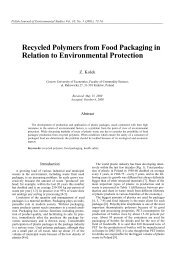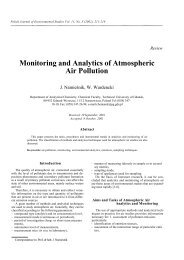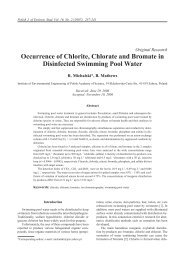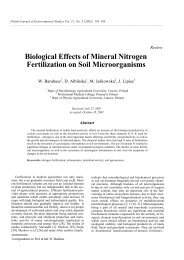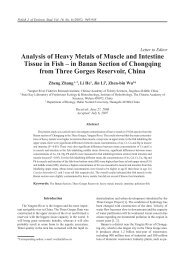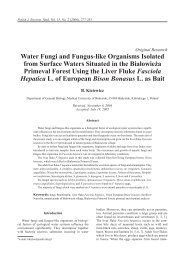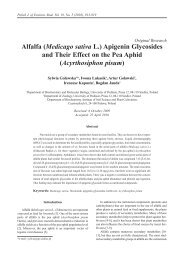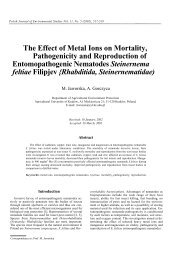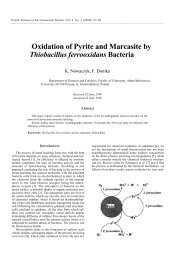Ecological Replacements of Ozone-Depleting Substances
Ecological Replacements of Ozone-Depleting Substances
Ecological Replacements of Ozone-Depleting Substances
You also want an ePaper? Increase the reach of your titles
YUMPU automatically turns print PDFs into web optimized ePapers that Google loves.
422<br />
As follows from the above evidence, the mechanism<br />
<strong>of</strong> formation and destruction <strong>of</strong> stratospheric ozone is<br />
complex and has been only partly explained, because not<br />
all factors leading to its decay have been recognised. It<br />
has been estimated that one chlorine atom acting as<br />
a catalyst in the reaction <strong>of</strong> ozone decay is able to cause<br />
the destruction <strong>of</strong> 100,000 ozone molecules [58]. In the<br />
case <strong>of</strong> Halons, which are bromine analogues <strong>of</strong> Freons,<br />
the problem is more complex because in the stratosphere<br />
they undergo photolysis to release free bromine atoms,<br />
Br:<br />
e.g. CF 3 Br + hv (λ < 220 nm) -> CF 3 + Br (27)<br />
whose potential <strong>of</strong> ozone decay is about 20 times greater<br />
than that <strong>of</strong> Cl [32].<br />
The decay <strong>of</strong> ozone by free atoms <strong>of</strong> halogens involves<br />
intermediate XO radicals (where: X= OH, NO, CI, Br,<br />
whereas XO= HO 2 , HO 2 , NO 2 , ClO, BrO), which should<br />
be observed if chlorine is in fact responsible for the ozone<br />
destruction:<br />
O 3 + X -> O 2 + XO (28)<br />
XO + O -> O 2 + X (29)<br />
Net: O 3 + O -> 2O 2 (30)<br />
Satellite measurements have confirmed the presence <strong>of</strong><br />
this species in both the Arctic and Antarctic atmospheres<br />
during periods <strong>of</strong> severe ozone depletion [10, 51, 111,<br />
113, 114].<br />
The same extreme chemical stability that makes<br />
halogenated hydrocarbons non-toxic enables them to<br />
persist for years in the atmosphere and to enter the<br />
stratosphere. They reach the stratosphere through the<br />
tropopause by slow diffusion or through tropopause gaps<br />
[10, 24, 32, 58]. As mentioned earlier these substances,<br />
non-reactive under tropospheric conditions are photochemically<br />
destroyed in the stratosphere to form chlorine<br />
atoms, which leads to ozone decay by the Cl-ClO cycle<br />
[10, 70, 77, 93].<br />
The time <strong>of</strong> a given halocarbon presence in the atmosphere<br />
is determined by its chemical composition and may<br />
range from a few months to a few hundred years [9, 10].<br />
It has been estimated that in 1945 the mean global<br />
concentration <strong>of</strong> chlorine in the atmosphere was about<br />
lppm, which makes 25% <strong>of</strong> all chlorine <strong>of</strong> anthropogenic<br />
origin, whereas in 1995 these values increased to 3.5 and<br />
85%, respectively [43, 76, 90, 94, 115].<br />
Stratospheric ozone constitutes a natural shield-protecting<br />
mankind from excess ultra-violet (UV) radiation.<br />
UV radiation is believed to cause an increased risk <strong>of</strong><br />
skin cancer and possibly also a suppression <strong>of</strong> the human<br />
immune system [10, 70].<br />
Iodine atoms readily attack ozone, but carbon iodine<br />
bonds are so easily photolysed by sunlight that not much<br />
<strong>of</strong> CF 3 J released at ground level would ever reach the<br />
stratosphere [80, 113]. Besides, researchers note the huge<br />
volume <strong>of</strong> natural iodocarbons produced by marine life<br />
WachowskiL.etal.<br />
dwarfs (given <strong>of</strong>f by the oceans to the stratosphere). Any<br />
potential industrial emission <strong>of</strong> CF 3 J would probably<br />
amount to just 1 to 3% <strong>of</strong> natural emission [46, 47, 116].<br />
The contribution <strong>of</strong> HFC degradation products to<br />
stratospheric ozone loss, increasing radiative forcing and<br />
pollution <strong>of</strong> aqueous environment has been recently assessed<br />
[10, 117]. All the degradation products were all<br />
found to be in trace amounts, although there is concern<br />
over the fate and toxicity <strong>of</strong> long-lived degradation products<br />
such as trifluoroacetic acid, TEA [118].<br />
Increased intensities <strong>of</strong> ground level ultraviolet radiation<br />
caused by stratospheric ozone destruction (depletion)<br />
would have some significant adverse consequences<br />
[10, 58]. The UV-B radiation <strong>of</strong> the wavelengths<br />
in the range 280-320 nm is necessary to sustain life and its<br />
lack or deficiency is responsible for a number <strong>of</strong> conditions<br />
like avitaminosis and rickets. However, a too high<br />
dose <strong>of</strong> this radiation also leads to harmful effects [119,<br />
123-127].<br />
The effects <strong>of</strong> most concern to humans are the elevated<br />
occurrence <strong>of</strong> skin cancer in individuals exposed to<br />
UV-B radiation, particularly near midday [122-125]. This<br />
spectral range is harmful because it can be adsorbed in<br />
the tail <strong>of</strong> the absorption band <strong>of</strong> DNA (λ max ≈ 260-280<br />
nm). It is postulated that under the influence UV-B radiation<br />
the function <strong>of</strong> DNA changes leading to improper<br />
transfer <strong>of</strong> the genetic code during cell division. This can<br />
result in uncontrolled cell division leading to skin cancer.<br />
People with light complexions lack protective melanin,<br />
which absorbs UV-B radiation and are especially susceptible<br />
to the effects <strong>of</strong> radiation. The most common type<br />
<strong>of</strong> skin cancer resulting from UV exposure is squamous<br />
cell carcinoma, which causes lesions that are readily removed<br />
and which has little tendency to spread (methastasises)<br />
[126-128]. Readily methastasised malignant<br />
melanoma caused by human exposure to UV-B radiation<br />
is <strong>of</strong>ten fatal. Fortunately, this form <strong>of</strong> skin cancer is<br />
relatively uncommon [122, 129]. It can also result in an<br />
increased incidence <strong>of</strong> cataracts [129]<br />
Other negative effects <strong>of</strong> too high irradiation would<br />
be on plants including crops used for food and destruction<br />
<strong>of</strong> microscopic plants that are the basis <strong>of</strong> the world's<br />
seas (phitoplancton) [130-133]. Too high doses <strong>of</strong> UV-B<br />
irradiation inhibit the process <strong>of</strong> photosynthesis and<br />
hence slow down the growth <strong>of</strong> vegetation. However,<br />
some evidence has been provided that in periods <strong>of</strong> the<br />
most intense UV irradiation the phitoplancton in the<br />
Arctic waters is the most abundant [133].<br />
Assessment <strong>of</strong> the harmful effect <strong>of</strong> compounds belonging<br />
to the group <strong>of</strong> ODS's is performed with the aid<br />
<strong>of</strong> a few indices. It is obviously important, for control and<br />
legislation, to estimate a chlorine loading potential<br />
(CLP) and bromine loading potential (BLP) <strong>of</strong> different<br />
natural and anthropogenic origin halocarbons to the atmosphere.<br />
These potentials are effectively increased with<br />
the tropospheric load <strong>of</strong> the relevant halogen brought<br />
about by the release <strong>of</strong> a fixed mass <strong>of</strong> the halocarbon,<br />
measured relative to the loading <strong>of</strong> the same amount <strong>of</strong><br />
a reference compound, which is always CC1 3 F (CFC-11)<br />
from the Earth surface [10]. In the terms <strong>of</strong> residence<br />
times, i, and relative molecular masses, M, CLP is given<br />
by the equation:



